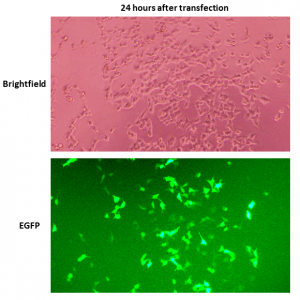A large number of ACVR1/ALK2 inhibitors were previously synthesised by Paul Brenner’s team (Target Discovery Center, University of Oxford) for the purpose of treating Fibrodysplasia Ossificans Progressiva (FOP). Although these compounds were not designed with blood-brain-barrier permeability in mind, they can serve as good bench-marks for my cellular assays. Therefore, 30 of these legacy compounds were chosen to be tested before other new bespoke Diffused Intrinsic Pontine Glioma (DIPG) compounds from Ontario Institute for Cancer Research (OICR) and Charles River Laboratories (CRL).

EGFP signal in transfected cells. HEK293 were transfected efficiently. Cells can be harvested for nanoBRET assay.

Chemical structures and NanoBRET IC50 curves of the first 10 legacy ACVR1/ALK2 inhibitors. IC50 values estimated by GraphPad Prism are shown in green.

Chemical structures and NanoBRET IC50 curves of the next 10 legacy ACVR1/ALK2 inhibitors. IC50 values estimated by GraphPad Prism are shown in green.

Chemical structures and NanoBRET IC50 curves of the last 10 legacy ACVR1/ALK2 inhibitors. IC50 values estimated by GraphPad Prism are shown in green.
Some of the legacy ACVR1/ALK2 inhibitors are very potent (M4K1062, M4K1210, M4K 1187, M4K1134, M4K1139, M4K1212, M4K1216, M4K1046). However, their off-target activity towards TGFBR1/ALK5 still needed to be determined. Inhibition of TGFBR1/ALK5 leads to cardiac toxicity. Since I have not yet been able to establish a robust nanoBRET target engagement assay for TGFBR1/ALK5, I will have to resort to dual luciferase promoter assay (orthologous assay) for the time being.
The full video recording of my monthly M4K pharma (an open science pharma) meeting can be found on youtube.
For experimental details, please visit my Zenodo post.

Jong Fu, were these legacy compounds tested to see if they can cross the blood-brain barrier? Could they be good leads for both FOP and DIPG?